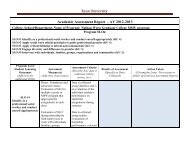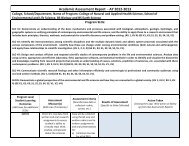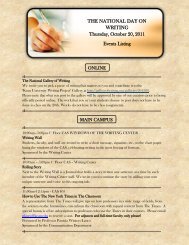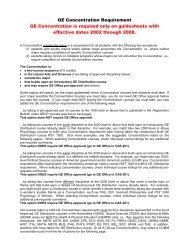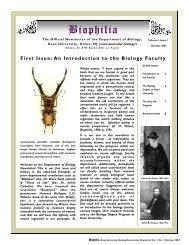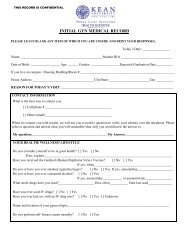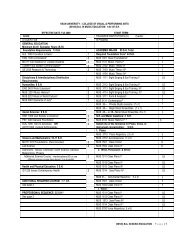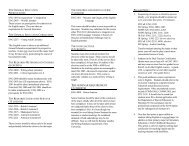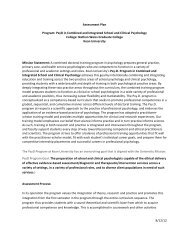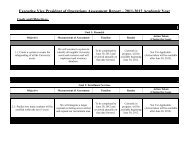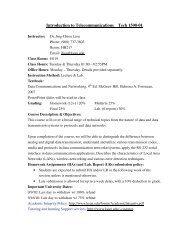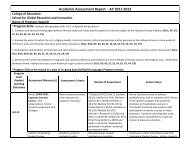Academic Assessment Report - AY 2012 - Kean University
Academic Assessment Report - AY 2012 - Kean University
Academic Assessment Report - AY 2012 - Kean University
You also want an ePaper? Increase the reach of your titles
YUMPU automatically turns print PDFs into web optimized ePapers that Google loves.
<strong>Academic</strong> <strong>Assessment</strong> <strong>Report</strong> - <strong>AY</strong> <strong>2012</strong><br />
College, School/Department, Name of Program:<br />
College of Education<br />
School of Communication Disorders and Deafness<br />
Graduate Program in Speech-Language Pathology<br />
Program SLOs:<br />
<strong>Kean</strong> <strong>University</strong><br />
Accredited by the Council on <strong>Academic</strong> Accreditation in Audiology and Speech-Language Pathology of the American<br />
Speech-Language-Hearing Association (ASHA), our program adheres to nationally recognized professional standards. Each<br />
student must evidence satisfactory completion of the Knowledge and Skills Acquisition (KASA) set, which we monitor<br />
using the Student <strong>Assessment</strong> Management System (SAMS), a web-based tracking program where all data are collected<br />
and monitored, accessible to both faculty and students, charting progress toward meeting program and KASA<br />
requirements.<br />
Program Student Learning Outcomes:<br />
SLO1: demonstrate knowledge of basic human communication and swallowing processes, including their biological, neurological, acoustic, psychological,<br />
developmental, and linguistic and cultural bases (KU 4)<br />
SLO2: demonstrate knowledge of the nature of speech, language, hearing and communication disorders and differences and swallowing disorders,<br />
including their etiologies, characteristics, anatomical/physiological, acoustic, psychological, developmental, and linguistic and cultural correlates (KU 1-4)<br />
SLO3: possess knowledge and skills reflective of the principles and methods of prevention, assessment and intervention for people with communication<br />
and swallowing disorders, with specific reference to articulation, fluency, voice and resonance, receptive/expressive language, hearing, swallowing as well<br />
as the cognitive and social aspects of communication (KU 1-4)<br />
SLO4: have knowledge of standards of ethical conduct and contemporary professional issues and certification (KU 2 & 4)<br />
SLO5: have knowledge of processes used in research and the integration of research principles into evidence-based clinical practice (KU 1-4)<br />
SLO6: has knowledge of and experience with individuals from culturally/linguistically diverse backgrounds and with client/patient populations across the life<br />
span (KU 1-3)
Program Level<br />
Student Learning<br />
Outcomes<br />
<strong>Assessment</strong><br />
Measure(s)<br />
<strong>Assessment</strong> Criteria<br />
Results of <strong>Assessment</strong><br />
Action Taken<br />
(Closing the Loop: New action or follow<br />
up from last <strong>Assessment</strong> <strong>Report</strong>)<br />
SLO1: demonstrate<br />
knowledge of basic<br />
human communication<br />
and swallowing<br />
processes, including their<br />
biological, neurological,<br />
acoustic, psychological,<br />
developmental, and<br />
linguistic and cultural<br />
bases (KU 4)<br />
Direct: Student<br />
<strong>Assessment</strong><br />
Management System<br />
(SAMS see above<br />
description) for basic<br />
process prerequisite<br />
courses: CDD 2251<br />
Introduction to Speech,<br />
Language and Hearing<br />
Disorders, CDD 2254<br />
Phonetics, CDD 2255<br />
Language Development,<br />
CDD 2260 Anatomy and<br />
Physiology of the Ear and<br />
Speech Mechanism, CDD<br />
3251 Speech Science,<br />
CDD 3258 Disorders of<br />
Speech Production and<br />
Voice, CDD 3259 Basic<br />
Audiology and CDD 3269<br />
Neuroscience for Speech<br />
and Hearing<br />
Learning markers for<br />
basic communication<br />
processes coursework<br />
are entered based on<br />
transcripts for 50 first<br />
year students<br />
Recent analyses of the<br />
learning markers revealed<br />
weakness in knowledge base<br />
in neuroscience<br />
Added required course in Neuroscience<br />
for the SLP to basic human<br />
communication processes coursework<br />
which revealed a slight improvement in<br />
student performance in CDD 5231<br />
Aphasia, CDD 5238 Motor Speech<br />
Disorders, and CDD 5269 Dysphagia. This<br />
conclusion was based on professors’<br />
judgments, but will now be quantified<br />
and analyzed when we have collected<br />
two years of data (grades) for CDD 5231:<br />
Aphasia (50 students per year), CDD<br />
5239: Motor Speech (25 students per<br />
year), and CDD 5269: Dysphagia (50<br />
students per year) to compare with the<br />
two years of data prior to the<br />
introduction of the required Neuro for<br />
SLP course .<br />
Praxis Scores (from 45<br />
second year students)<br />
Indirect: Number of<br />
students in need of<br />
remediation plans for<br />
grades less than B in basic<br />
communication processes<br />
Praxis Scores are<br />
analyzed by categories,<br />
one of which is basic<br />
human communication<br />
disorders and<br />
swallowing<br />
Grades less than B<br />
identified at end of<br />
each semester<br />
Praxis scores were<br />
determined to be a strength<br />
for our students<br />
A total of 4 remediation<br />
plans for CDD 5231 Aphasia,<br />
CDD 5238 Motor Speech<br />
Disorders, and CDD 5269<br />
Dysphagia prior to the<br />
No action required<br />
First year anecdotal data collected, to be<br />
followed by data collection (grades) for<br />
next two years for comparison with preand<br />
post-neuroscience course grades for<br />
three courses listed above see above)
coursework (CDD 5231<br />
Aphasia, CDD 5238 Motor<br />
Speech Disorders and<br />
CDD 5269 Dysphagia)<br />
introduction of CDD 3269<br />
Neuroscience for the SLP<br />
SLO2: demonstrate<br />
knowledge of the nature<br />
of speech, language,<br />
hearing and<br />
communication disorders<br />
and differences and<br />
swallowing disorders,<br />
including their etiologies,<br />
characteristics,<br />
anatomical/physiological,<br />
acoustic, psychological,<br />
developmental, and<br />
linguistic and cultural<br />
correlates (KU 1-4)<br />
Graduating Student<br />
Survey<br />
Direct: SAMS data for<br />
CDD 5229: Disorders of<br />
Phonology and<br />
Articulation, CDD 5231:<br />
Aphasia, CDD 5235:<br />
Language Disorders in<br />
Children, CDD 5240<br />
Disorders of Fluency, CDD<br />
5262 Disorders of Voice,<br />
CDD 5264: Augmentative<br />
and Alternative<br />
Communication, and CDD<br />
5269: Dysphagia<br />
Comprehensive Exam<br />
Indirect:<br />
Graduating Student<br />
Survey<br />
47 students completed<br />
the survey<br />
Learning markers for<br />
knowledge of<br />
communication<br />
disorders are entered<br />
based on transcripts<br />
for 50 first year<br />
students and 50<br />
second year students<br />
These data are<br />
collected at<br />
appropriate intervals<br />
(November, March and<br />
June, for a total of 50<br />
second year students)<br />
47 students completed<br />
the survey<br />
Based on a scale of 1-5, 1<br />
being “strongly agree,” the<br />
mean response was 1.45<br />
Students moved from<br />
“developing” to “entry level<br />
proficient” in knowledge of<br />
specific communication<br />
disorders, as prescribed by<br />
the ASHA KASA (see above<br />
description)<br />
One student failed the<br />
comprehensive examination<br />
during <strong>AY</strong> <strong>2012</strong> and three<br />
failed the SLP Praxis test<br />
(out of 47 students)<br />
Mean response for “strongly<br />
agree” was 1.38<br />
No action required<br />
No action required unless a remediation<br />
plan is required for a particular student<br />
Students were either placed in a study<br />
group for the next administration of the<br />
exam or they enrolled in test review<br />
classes.<br />
No action required<br />
SLO3: possess<br />
knowledge and skills<br />
reflective of the<br />
principles and methods<br />
of prevention,<br />
assessment and<br />
intervention for people<br />
Direct: SAMS - data from<br />
CDD 5202 Clinical<br />
Methods in SLP, CDD<br />
5227/8 Advanced Clinical<br />
Practica in SLP 1 & 2,<br />
Data from clinical skill<br />
evaluations after each<br />
practicum are entered<br />
at the end of each of<br />
the four clinical<br />
experiences. These are<br />
numerical ratings that<br />
One student required to<br />
repeat first clinical<br />
experience as a remediation<br />
No action required unless a remediation<br />
plan is required for a particular student.<br />
While data have not been aggregated<br />
previously, a data base program is being<br />
developed to enable us to do this next<br />
year.
with communication and<br />
swallowing disorders,<br />
with specific reference to<br />
articulation, fluency,<br />
voice and resonance,<br />
receptive/expressive<br />
language, hearing,<br />
swallowing as well as the<br />
cognitive and social<br />
aspects of<br />
communication (KU 1-4)<br />
CDD 5229: Disorders of<br />
Phonology and<br />
Articulation, CDD 5231:<br />
Aphasia, CDD 5235:<br />
Language Disorders in<br />
Children, CDD 5240<br />
Disorders of Fluency, CDD<br />
5262 Disorders of Voice,<br />
CDD 5264: Augmentative<br />
and Alternative<br />
Communication, and CDD<br />
5269: Dysphagia<br />
are assigned to a<br />
student’s performance<br />
in each of their clinical<br />
practica, both on<br />
campus and out on<br />
externships.<br />
Learning markers for<br />
prevention,<br />
assessment and<br />
intervention<br />
coursework are<br />
entered based on<br />
transcripts for 25 first<br />
on-campus clinical<br />
experience students<br />
and 25 second on –<br />
campus clinical<br />
experience students<br />
and for 50 clinical<br />
externs each semester<br />
year round.<br />
Students moved from<br />
“developing” to “entry level<br />
proficient” in ability to<br />
assess, treat and prevent<br />
communication and<br />
swallowing disorders<br />
No action required unless a remediation<br />
plan is required for a particular student<br />
Praxis Scores<br />
Overall and category<br />
scores are analyzed<br />
Praxis scores were<br />
determined to be a strength<br />
for our students<br />
No action required<br />
Comprehensive Exam<br />
Indirect: Graduating<br />
Student Survey<br />
Scores and pass rate<br />
data are collected at<br />
appropriate intervals<br />
(November, March and<br />
June for a total of 50<br />
second year students)<br />
47 students completed<br />
the survey<br />
One student failed the<br />
Comprehensive Exam this<br />
year<br />
Mean response for “strongly<br />
agree” was 1.42<br />
Student was placed in a study group<br />
preparing for the next administration of<br />
the exam<br />
No action required<br />
SLO4: have knowledge of<br />
standards of ethical<br />
conduct and<br />
Direct: SAMS data from<br />
CDD 5237: Contemporary<br />
Issues in SLP are entered<br />
Final grade of B or<br />
better for this online<br />
class<br />
All students passed this<br />
required class, but results<br />
for specific student<br />
Next year, the two ASHA assessments will<br />
be entered on SAMS as “trackables.” In<br />
addition, this course by its very nature
contemporary<br />
professional issues and<br />
certification (KU 2 & 4)<br />
(for a total of 25-50<br />
students each year<br />
depending on when in<br />
their programs they take<br />
this required class).<br />
performance on ASHA Ethics<br />
Questionnaire as well as<br />
ASHA Cultural Sensitivity<br />
Quiz are not recorded<br />
separately<br />
must be continually updated due to the<br />
changing nature of the state and federal<br />
legislative and regulatory climates<br />
Comprehensive Exam<br />
Indirect: Graduating<br />
Student Survey<br />
Scores and pass rate<br />
data are collected at<br />
appropriate intervals<br />
(November, March and<br />
June for a total of 50<br />
second year students)<br />
47 students completed<br />
the survey<br />
One student failed the<br />
Comprehensive Exam this<br />
year<br />
Mean response for “strongly<br />
agree” was 1.40<br />
Student reviewed the exam with the<br />
professors who wrote the questions that<br />
were failed and the student was placed in<br />
a study group preparing for the next<br />
administration of the exam<br />
No action required<br />
SLO5: have knowledge of<br />
processes used in<br />
research and the<br />
integration of research<br />
principles into evidencebased<br />
clinical practice<br />
(KU 1-4)<br />
Direct: SAMS data from<br />
CDD 5298 Advanced<br />
Seminar in Research in<br />
SLP I for 50 first year<br />
students<br />
SAMS data and clinical<br />
evaluation forms from<br />
CDD 5227/5228 Advanced<br />
Clinical Practicum in SLP I<br />
& II<br />
Students must receive<br />
IRB approval for their<br />
research studies by the<br />
end of CDD 5298 in<br />
order to begin data<br />
collection<br />
Student must integrate<br />
Evidence-Based<br />
Practice rationales in<br />
all clinical activity,<br />
reflected in the<br />
successful completion<br />
of each clinical<br />
experience with a<br />
grade of B or better<br />
Occasionally a student<br />
requires an “incomplete”<br />
grade and required more<br />
time, but typically all of the<br />
students receive approval in<br />
a timely manner<br />
This was accomplished since<br />
failure to use EBP was not<br />
the reason for two students<br />
to need a remediation plan<br />
following a clinical<br />
experience<br />
No action required<br />
No action required<br />
SAMS data from CDD<br />
5299 Advanced Seminar<br />
in Research in SLP II for 50<br />
A completed thesis<br />
(including the College<br />
of Education rubric for<br />
Most students, with an<br />
occasional student requiring<br />
extra time, complete the<br />
Consistent use of the College of Education<br />
evaluation rubric, making it a “trackable”<br />
on SAMS which will enable us to
second year students<br />
n.b. 5298-5299 is a<br />
Spring-Fall sequence<br />
rather than a Fall-Spring<br />
sequence hence the<br />
students begin it in their<br />
first year and complete it<br />
in their second year<br />
evaluating a thesis<br />
project) and<br />
presentation at <strong>Kean</strong><br />
<strong>University</strong> Research<br />
Days are required<br />
requirements for 5298 and<br />
5299 in a timely manner;<br />
however, the <strong>Kean</strong><br />
<strong>University</strong> College of<br />
Education thesis project<br />
evaluation rubric has not<br />
been used consistently<br />
qualitatively evaluate each thesis rather<br />
than just assigning a letter grade to it<br />
Indirect: Graduating<br />
Student Survey<br />
47 students completed<br />
the survey<br />
Mean response for “strongly<br />
agree” was 1.39<br />
No action required<br />
Evidence-Based Practice<br />
(EBP) is infused in all of<br />
the required disorderbased<br />
courses (listed<br />
above in SLOs 2 and 3)<br />
Reflected in the<br />
learning markers which<br />
are entered into SAMS<br />
for these courses<br />
Successful course<br />
completion considered to<br />
reflect EBP proficiency<br />
No action required<br />
SLO6: has knowledge of<br />
and experience with<br />
individuals from<br />
culturally/linguistically<br />
diverse backgrounds and<br />
with client/patient<br />
populations across the<br />
lifespan (KU 1-3)<br />
Direct: SAMS data for all<br />
academic and clinical<br />
graduate level<br />
coursework for 50-100<br />
first and second year<br />
students<br />
Learning markers for all<br />
required courses are<br />
entered into SAMS,<br />
reflecting the<br />
integration of cultural<br />
and linguistic<br />
sensitivity/diversity<br />
into all of these<br />
courses, which will be<br />
reflected in students’<br />
clinical diagnostic and<br />
treatment practices<br />
(which in turn are<br />
evaluated individually<br />
and indirectly by clinic<br />
supervisor assigned to<br />
each student)<br />
<strong>Kean</strong> <strong>University</strong> continues to<br />
be a culturally and<br />
linguistically diverse student<br />
body, and the <strong>Kean</strong><br />
<strong>University</strong>’s Center for<br />
Communication Disorders<br />
SLP graduate students<br />
successfully serve a diverse<br />
community of clients across<br />
the lifespan. Census<br />
numbers range each<br />
semester year round from<br />
50-75 student clinicians<br />
serving upwards of 125<br />
clients during a semester<br />
including toddlers to<br />
geriatric clients who come<br />
from a variety of cultures<br />
and who speak a variety of<br />
languages<br />
No action required
Indirect: Graduating<br />
Student Survey<br />
47 students completed<br />
the survey<br />
Mean response for “strongly<br />
agree” was 1.45<br />
No action required<br />
<strong>Kean</strong> <strong>University</strong> is in the top<br />
five universities in the<br />
United States for “diversity”<br />
<strong>Kean</strong> and the community it<br />
serves is extremely diverse<br />
across parameters of<br />
culture, race, ethnicity and<br />
language, so it is part of who<br />
we all are, i.e., we “live” it so<br />
we don’t really “assess” it<br />
A new course in Bilingual<br />
Speech-Language<br />
Pathology was offered<br />
this year for the first time<br />
by a multilingual<br />
professor who is currently<br />
developing a Bilingual SLP<br />
concentration within our<br />
MA program<br />
This course is being<br />
evaluated by several of<br />
our bilingual students<br />
and the instructor both<br />
on content as well as<br />
part of a self-study<br />
process for the<br />
Bilingual SLP<br />
concentration<br />
development<br />
So far, only “rave reviews”<br />
and great enthusiasm for a<br />
bilingual concentration;<br />
formal course evaluations<br />
are not yet available<br />
The Bilingual SLP concentration<br />
development is continuing through the<br />
Summer <strong>2012</strong>, with a report on progress<br />
and proposal due during the Fall <strong>2012</strong><br />
semester<br />
Clinical evaluations after<br />
each clinical experience<br />
Clinical caseloads<br />
attempt to provide<br />
diversity across many<br />
different parameters<br />
Clinical experience was<br />
noted to be widely<br />
diversified across age,<br />
culture and presenting<br />
communication disorder<br />
Continue to monitor and balance this for<br />
every student across four required clinical<br />
experiences<br />
n.b. 266 out of the 270 possible responses to the <strong>Kean</strong> <strong>University</strong> Qualtrics online survey from 47 graduating Speech-Language Pathology<br />
graduate students regarding their entry-level proficiencies associated with the six SLOs based on the American Speech-Language-Hearing<br />
Association’s (ASHA) Knowledge and Skills <strong>Assessment</strong> (KASA) were ranked “strongly agree” and “agree.”



